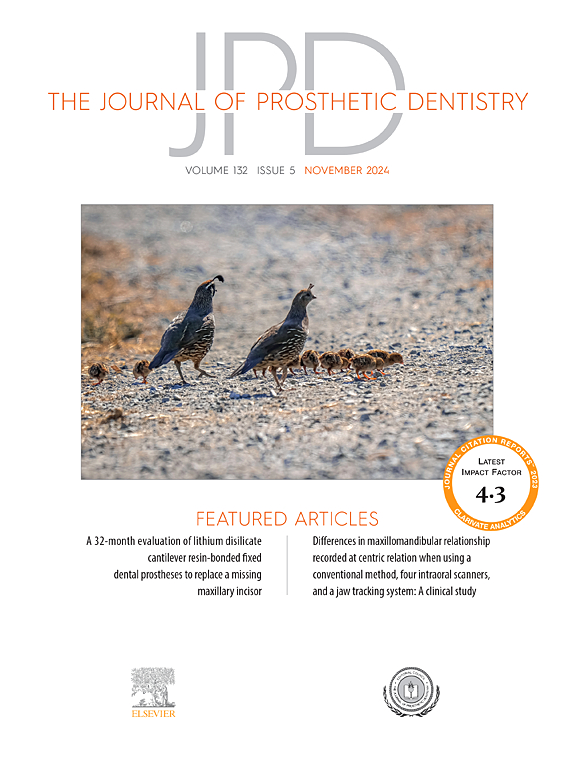三种聚酰胺和聚醚醚酮义齿附着体对种植覆盖义齿固位力的影响:体外研究。
IF 4.3
2区 医学
Q1 DENTISTRY, ORAL SURGERY & MEDICINE
引用次数: 0
摘要
问题陈述:种植支撑覆盖义齿附着体固位能力的丧失与固位插入物的磨损有关。在固定镶件更换期间,需要调查基台涂层材料的磨损情况。目的:本体外研究的目的是比较3种聚酰胺和聚醚醚酮义齿附着体在潮湿条件下重复插入和取出周期并遵循其制造商推荐的更换时间时固位力的变化。材料和方法:对四种不同的义齿附着体(LOCKiT, OT-Equator, Ball附着体和Novaloc)及其固位植入物进行了测试。四个种植体嵌入到单独的丙烯酸树脂块中,每个附着体使用10个基台。40个金属外壳及其固定插入物用自聚合丙烯酸树脂连接到聚酰胺螺钉上。使用定制的通用试验机模拟插入和拔出周期。分别在第0、540、2700、5400次循环时,将试件安装在另一台万能试验机上,记录最大固力。LOCKiT(轻度固位)、OT-Equator(软固位)和Ball附件(软固位)的固定式嵌套每540个周期更换一次,而Novaloc(中等固位)附件从未更换过。所有的桥台都用精确的天平在0、2700和5400次循环时称重。每个基牙的表面在×10放大镜下进行立体显微镜检查。资料用描述性统计进行分析。采用双向重复测量方差分析比较各组平均固位力、平均基台质量及时间评价点。进行Bonferroni校正以校正多次试验(α= 0.05)。结果:LOCKiT在模拟使用6个月后的平均保留率为12.6%,在模拟使用5年后的平均保留率为45.0%。OT-Equator在模拟使用6个月后的平均保留率为16.0%,5年后的平均保留率为50.1%。在模拟使用6个月后,Ball附着体的平均固位损失为15.3%,在模拟使用5年后为39.1%。Novaloc在模拟使用6个月后的平均保留率为31.0%,5年后的平均保留率为59.1%。OT-Equator和Novaloc在基线、2.5年和5年的平均基台质量差有统计学意义(p < 0.05)。结论:在实验条件下,所有被测试的附着体都记录了固位损失,即使它们的制造商建议更换固位插入物的时间是遵循的。患者应该意识到种植基台应该在推荐的时间后更换,因为它们的表面也会随着时间的推移而变化。本文章由计算机程序翻译,如有差异,请以英文原文为准。
Retentive force variations in three polyamide and a polyetheretherketone denture attachments for implant-supported overdentures: An in vitro study
Statement of problem
The loss in the retentive capability of implant-supported overdenture attachments has been related to the wear of the retentive inserts. Wear of the abutment coating material when following the replacement period for the retentive inserts requires investigation.
Purpose
The purpose of this in vitro study was to compare the changes in retentive force of 3 polyamide and a polyetheretherketone denture attachments under repeated insertion and removal cycles in wet conditions while following their manufacturers’ replacement time recommendations.
Material and methods
Four different denture attachments (LOCKiT, OT-Equator, Ball attachment, and Novaloc) with their retentive inserts were tested. Four implants were embedded into individual acrylic resin blocks, and 10 abutments for each attachment were used. Forty metal housings with their retentive inserts were attached to polyamide screws with autopolymerizing acrylic resin. A customized universal testing machine was used to simulate insertion and removal cycles. The specimens were mounted on a second universal testing machine at 0, 540, 2700, and 5400 cycles, and the maximum retentive force was recorded. The retentive inserts for LOCKiT (light retention), OT-Equator (soft retention), and Ball attachment (soft retention) were replaced every 540 cycles, while the Novaloc (medium retention) attachments were never replaced. All the abutments were weighed with a precision scale at 0, 2700, and 5400 cycles. The surface of every abutment was examined under a stereomicroscope at ×10 magnification. Data were analyzed with descriptive statistics. Two-way repeated measures ANOVA was used to compare the mean retentive force and mean abutment mass of all groups and time evaluation points. Bonferroni corrections were made to adjust for multiple tests (α=.05).
Results
The mean retention loss for LOCKiT was 12.6% after 6 months and 45.0% after 5 years of simulated use. The mean retention loss for OT-Equator was 16.0% after 6 months and 50.1% after 5 years of simulated use. The mean retention loss for Ball attachment was 15.3% after 6 months and 39.1% after 5 years of simulated use. The mean retention loss for Novaloc was 31.0% after 6 months and 59.1% after 5 years of simulated use. The mean abutment mass difference was statistically significant (P<.05) for LOCKiT and Ball attachment but not statistically significant (P>.05) for OT-Equator and Novaloc at baseline, 2.5 years, and 5 years.
Conclusions
All tested attachments recorded retention loss under the experimental conditions, even when their manufacturers’ recommendations for replacement time for the retentive inserts were followed. Patients should be aware that implant abutments should be replaced after a recommended period since their surfaces also change over time.
求助全文
通过发布文献求助,成功后即可免费获取论文全文。
去求助
来源期刊

Journal of Prosthetic Dentistry
医学-牙科与口腔外科
CiteScore
7.00
自引率
13.00%
发文量
599
审稿时长
69 days
期刊介绍:
The Journal of Prosthetic Dentistry is the leading professional journal devoted exclusively to prosthetic and restorative dentistry. The Journal is the official publication for 24 leading U.S. international prosthodontic organizations. The monthly publication features timely, original peer-reviewed articles on the newest techniques, dental materials, and research findings. The Journal serves prosthodontists and dentists in advanced practice, and features color photos that illustrate many step-by-step procedures. The Journal of Prosthetic Dentistry is included in Index Medicus and CINAHL.
 求助内容:
求助内容: 应助结果提醒方式:
应助结果提醒方式:


